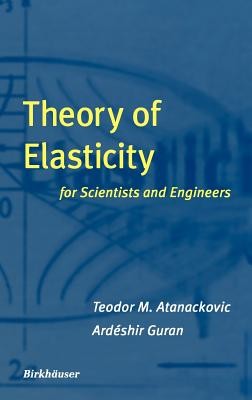
- We will send in 10–14 business days.
- Author: Teodor M Atanackovic
- Publisher: Birkhäuser
- ISBN-10: 081764072X
- ISBN-13: 9780817640729
- Format: 16.1 x 24.2 x 2.4 cm, hardcover
- Language: English
- SAVE -10% with code: EXTRA
Theory of Elasticity for Scientists and Engineers (e-book) (used book) | bookbook.eu
Reviews
Description
This book is intended to be an introduction to elasticity theory. It is as- sumed that the student, before reading this book, has had courses in me- chanics (statics, dynamics) and strength of materials (mechanics of mate- rials). It is written at a level for undergraduate and beginning graduate engineering students in mechanical, civil, or aerospace engineering. As a background in mathematics, readers are expected to have had courses in ad- vanced calculus, linear algebra, and differential equations. Our experience in teaching elasticity theory to engineering students leads us to believe that the course must be problem-solving oriented. We believe that formulation and solution of the problems is at the heart of elasticity theory. 1 Of course orientation to problem-solving philosophy does not exclude the need to study fundamentals. By fundamentals we mean both mechanical concepts such as stress, deformation and strain, compatibility conditions, constitu- tive relations, energy of deformation, and mathematical methods, such as partial differential equations, complex variable and variational methods, and numerical techniques. We are aware of many excellent books on elasticity, some of which are listed in the References. If we are to state what differentiates our book from other similar texts we could, besides the already stated problem-solving ori- entation, list the following: study of deformations that are not necessarily small, selection of problems that we treat, and the use of Cartesian tensors only.
EXTRA 10 % discount with code: EXTRA
The promotion ends in 19d.04:55:06
The discount code is valid when purchasing from 10 €. Discounts do not stack.
- Author: Teodor M Atanackovic
- Publisher: Birkhäuser
- ISBN-10: 081764072X
- ISBN-13: 9780817640729
- Format: 16.1 x 24.2 x 2.4 cm, hardcover
- Language: English English
This book is intended to be an introduction to elasticity theory. It is as- sumed that the student, before reading this book, has had courses in me- chanics (statics, dynamics) and strength of materials (mechanics of mate- rials). It is written at a level for undergraduate and beginning graduate engineering students in mechanical, civil, or aerospace engineering. As a background in mathematics, readers are expected to have had courses in ad- vanced calculus, linear algebra, and differential equations. Our experience in teaching elasticity theory to engineering students leads us to believe that the course must be problem-solving oriented. We believe that formulation and solution of the problems is at the heart of elasticity theory. 1 Of course orientation to problem-solving philosophy does not exclude the need to study fundamentals. By fundamentals we mean both mechanical concepts such as stress, deformation and strain, compatibility conditions, constitu- tive relations, energy of deformation, and mathematical methods, such as partial differential equations, complex variable and variational methods, and numerical techniques. We are aware of many excellent books on elasticity, some of which are listed in the References. If we are to state what differentiates our book from other similar texts we could, besides the already stated problem-solving ori- entation, list the following: study of deformations that are not necessarily small, selection of problems that we treat, and the use of Cartesian tensors only.


Reviews